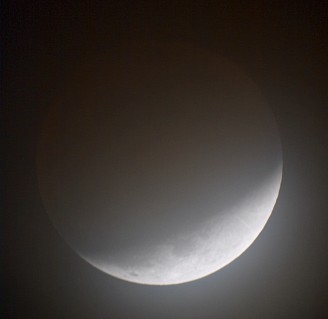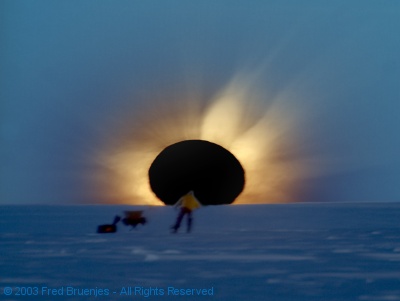| ||||||||||||||||||
| ||||||||||||||||||
|
A solar eclipse occurs when the Moon blocks out the Sun. This is what the Sun normally looks like, through a solar filter. The Sun is so bright that, without a filter, it would burn (as in smoke!) anything or anyone that is looking through a telescope at it.
This photograph shows numerous "sunspots", which are active regions on the Sun. The largest ones shown in this photo are about the size of the Earth! Sunspots come and go on an 11 year cycle, which we are near the peak of. A few years ago, it was rare to see a sunspot. |

|

| I was fortunate to live at the end of the track for the January 1992 annular eclipse, so I got to see it at sunset by travelling less than five minutes from my house. This is an overexposed wide angle view taken shortly before annularity. Note the crescent reflected on the ocean. |
|
On November 15, 1999, the planet Mercury passed across the face of the Sun, as viewed from Earth (we astronomers call this a "transit"). This is a fairly rare event; the next two visible from the US will occur in 2006 and 2016. You can see the planet as a small dot on the upper-left hand edge of the Sun. Mercury never got far from the edge; this transit was a special one (a "grazing transit"), which is very rare.
Even more spectacular is when Venus transits, which will occur in 2004. The last time that happened was in 1882! |

|
 |

| This is a photo of the total lunar eclipse that occurred the night of January 21, 2000. This 30 second exposure was taken during the middle of the eclipse, and is very close in color to the view I saw with the naked eye. A lunar eclipse occurs when the Earth casts a shadow on the Moon. The color is determined by what is present in our atmosphere; volcano eruptions can have a significant impact. These happen every year or so, often a couple weeks before or after solar eclipses. |
|
This is a shot of the partial solar eclipse that happened on Christmas Day, 2000. What you see is the Sun with a piece missing because the Moon is in the way. A few sunspots are also visible. This was taken through my telescope, with a conventional 35mm SLR film camera.
Depending on where this eclipse was observed from in North America, more or less of the Sun was eclipsed. It just so happens that from my location in Southern California, I got the least eclipsed view in the entire continental United States! |

|
| The most spectacular of all eclipses is the total solar eclipse, when the Moon completely blocks out the sun. I finally saw one of these in Africa on June 21, 2001. I wrote an exhaustive report so I won't say too much here. |
 |
| On December 14th, 2001, an Annular Solar Eclipse graced the Pacific Rim. I saw it as a partial eclipse from San Diego, CA. Please click here for the full story. |

|

| I also attempted to see another sunset annular eclipse, this time in Puerto Vallarta, Mexico. Unfortunately, Tropical Storm Boris had other ideas and so I had to settle for a peek at the partial phase. Please click here for the full story. |
| Penumbral Lunar Eclipse of November 19, 2002. The Moon only grazed the Earth's shadow. Notice how the upper part of the Moon is darker than the lower part. |

|

| Another total solar eclipse I travelled to was in Australia on December 4th, 2002. Please click here for the full story. |
| This is an image of the Total Lunar Eclipse of May 15, 2003. This was taken after the total phase, as the Moon was emerging into sunlight after being in the Earth's shadow. This is a composite of three images: one exposed for the sunlit Moon, one for the Moon in shadow, and one deep mid-totality exposure for the stars. This was the best way to recreate the view seen by the human eye. |

|

| Another Lunar eclipse, very similar to the May eclipse above, took place on November 8th, 2003. Unfortunately a lot of high clouds were moving through so I couldn't get a clear shot of the Moon. Still, I was able to use this eclipse as a practice run for the total solar eclipse on the 23rd, by setting up my cameras the way I will at the solar eclipse in Antarctica. |
| After much nail biting and a six hour ride on a Russian cargo plane, I successfully observed the November 23, 2003 Total Solar Eclipse from near Novolazarevskaya, Antarctica. The full story is here. |

|

| I observed the October 27th, 2004 total lunar eclipse from an overlook near the Golden Gate Bridge in San Francisco, California. Click here for more photos. |
Why don't you head on to my Planets page now?
Or, you can go back to my main astronomy page for lots more good images!
Comments? Questions? Click here to send email to me, Fred Bruenjes.
All text and images are © 1992-2003 Manfred Bruenjes - All Rights Reserved. Image inlining (aka hot linking), and framing are strictly prohibited. Email for permission before using an image or text.